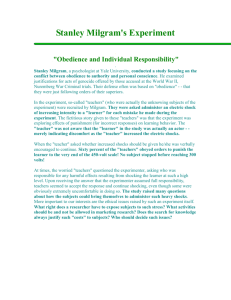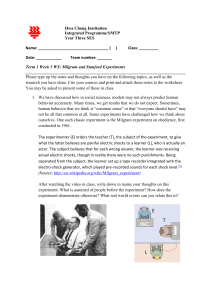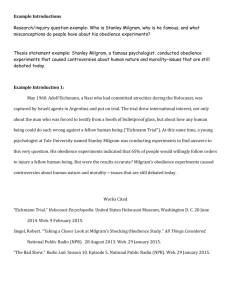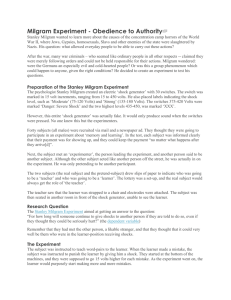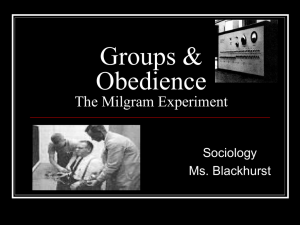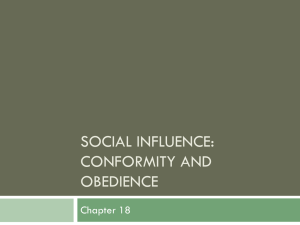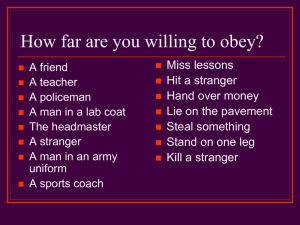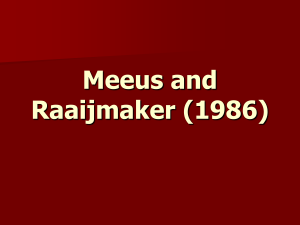Final Draft - Roy Y. Chan
advertisement
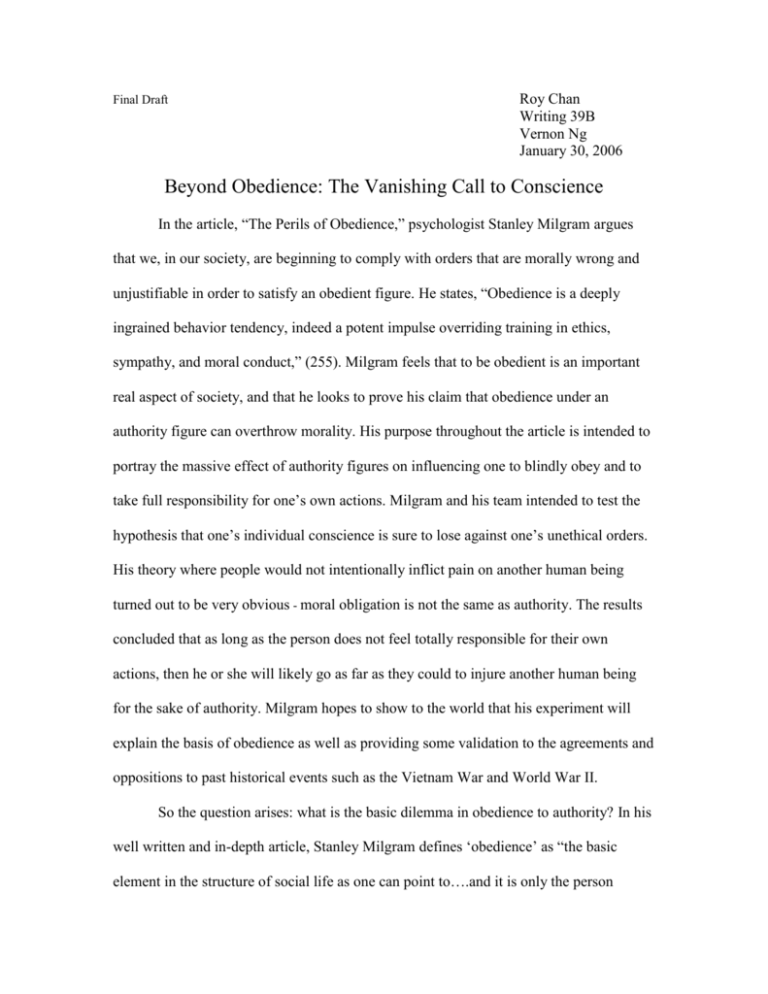
Final Draft Roy Chan Writing 39B Vernon Ng January 30, 2006 Beyond Obedience: The Vanishing Call to Conscience In the article, “The Perils of Obedience,” psychologist Stanley Milgram argues that we, in our society, are beginning to comply with orders that are morally wrong and unjustifiable in order to satisfy an obedient figure. He states, “Obedience is a deeply ingrained behavior tendency, indeed a potent impulse overriding training in ethics, sympathy, and moral conduct,” (255). Milgram feels that to be obedient is an important real aspect of society, and that he looks to prove his claim that obedience under an authority figure can overthrow morality. His purpose throughout the article is intended to portray the massive effect of authority figures on influencing one to blindly obey and to take full responsibility for one’s own actions. Milgram and his team intended to test the hypothesis that one’s individual conscience is sure to lose against one’s unethical orders. His theory where people would not intentionally inflict pain on another human being turned out to be very obvious - moral obligation is not the same as authority. The results concluded that as long as the person does not feel totally responsible for their own actions, then he or she will likely go as far as they could to injure another human being for the sake of authority. Milgram hopes to show to the world that his experiment will explain the basis of obedience as well as providing some validation to the agreements and oppositions to past historical events such as the Vietnam War and World War II. So the question arises: what is the basic dilemma in obedience to authority? In his well written and in-depth article, Stanley Milgram defines ‘obedience’ as “the basic element in the structure of social life as one can point to….and it is only the person dwelling in isolation who is not forced to respond, with defiance or submission,” (255). The method that Milgram utilizes is a simple psychology experiment consisting of two people coming into a psychology laboratory at Yale University. One of them is the teacher while the other is the learner. The experimenter fools the teacher, who is the subject, into thinking that the study focuses on the effects of punishment on learning. His initial experiment begins by placing the learner into an electric chair with electrodes attached to the learner’s wrist. The learner, who is actually an actor, is trained to react in a certain way depending on the intensity of the shock given. Milgram knows that the electric chair is indeed a fake, while the teacher, on the other hand, knows that it is in fact real. Fooling the teacher conscience, the experimenter utilizes his experiment in order to find the correlation between one’s obedience to authority and one’s individuality. The experimenter tells the teacher that he will read a list of words that will test the learner ability to think and remember the second word of a pair when he hears the first one again (258). If the learner is to make an incorrect error on one of the two words, then the teacher will administer an electric shock to the protesting victim. With the intensity of the shock increasing every time the learner fails to obey, the teacher would then begin to show some sign of tension as he deliver more intense amounts of voltage to the protesting learner. The experimenter assured to the teacher that he would take full responsibility for any harm done to the learner. Disagreeing with the experimenter authorities, the teacher then continued on to the very end of this experiment. The results of the experiments are such a shock to Milgram. Through his experimental design, researchers are able to conclude that 60% are obedient and up to 85% of the people obeyed in other countries around the world. It indicates how most people, when asked to obey, will disregard their own individual morals if they do not feel totally responsible for the results of their own actions. All these designs are broken down into three different experiments which allow Milgram to understand more on why people’s obedience under authority would overthrow morality. During Milgram’s first initial experiment, the experimenter would order Fred Prozi to deliver a higher amount of voltage anytime the learner fails to obey. With the intensity of the shock increasing every time the learner fails to obey, Prozi would then show some kind of tension and stress as he continue on to deliver more intense amounts of voltage to the protesting learner. During this procedure, researchers are able to note that the more hysterical Prozi become, the more likely he will give in to obedience under authority. Though the teacher is aware of the fact that the experimenter would take full responsibility for any harm done to the learner, Prozi’s nervousness throughout the experiment got the best out of his own ethical morals. During Milgram’s second experiment, Gretchen Brandt decided to forego Milgram’s experiment because of the learner’s heart condition and well-being. With her self-control and courteous behavior, Brandt is able to leave the experiment without causing any harm done to the protesting learner. Researchers are able to conclude that being calm and relax can in fact overthrow one’s unethical orders. The more relaxed one become, the more likely one will have total control over their thoughts, emotions, and behaviors. This example demonstrates how one’s individuality would shine through when one has the ability to take control over their conscience. Milgram’s various analyses are meant to serve as a warning to the public, that we must open our eyes to potential dangers of obedience under authority. He feels that his variations will prove to the public how most people, in our society, would ignore their own individuality when obeying orders that blatantly conflict their own values. Milgram believes that to conflict our own authority will severely paralyze action, while to be rebellious, on the other hand, will severely undermine authority. Milgram states, “Morality does not disappear – it acquires a radically different focus: the subordinate person feels shame or pride depending on how adequately he has performed the actions called for by authority,” (265). Despite how rude obedience is being portrayed in our country, Milgram feels that his experimental design will one day influence the way how we become obedient to authority in extreme circumstances. In closing, Milgram concludes that under a high authority figure, most people will remain obedient to the given instructions, even if it contradicts their own moral beliefs and ethics. When the experimenter told the teacher that he would not be responsible for the injury of the learner, the teacher is then more inclined to deliver the maximum amount of voltage. These experiments are such a shock to just about everyone since many believed that one’s own conscience would overthrow an authority’s order to hurt someone. His purpose throughout the article is meant to relieve social events from the past; that those who are accused from the acts and oppositions of the Vietnam War and World War II are all caused by ‘obedience’ – that fighters are just obeying orders under the authority of their superior. I believe that, after reviewing his article, Stanley Milgram argument is beginning to challenge us all whether we, Americans consider ourselves obedient or not. His overall argument throughout the article demonstrates how we, in our society, can easily be persuaded to commit torture, or, in fact, murder on innocent victims. One example that is closely related to ‘The Perils of Obedience’ is the US military torture of Abu Gharib in Iraq. The US military, who ordered several prisoners to perform oral sex, are asked to remain obedient to the given instructions or they will be electrocuted by the American guards. This torture done by the US guards is a definite example of how most people will contradict their own moral beliefs and ethics to satisfy an authority figure. Another example that is closely related to Milgram’s article is ‘The Stanford Prison Experiment’ done in 1971. The experiment, conducted by Philip Zimbardo, is a psychological experiment that test how the human mind would respond to the life inside prison walls. With Zimbardo’s experiment, researchers are able to find many patterns and markings that are closely related to Milgram’s article. Zimbardo is able to conclude that under a high authority, prisoners are likely to become more zealously obedient to authority. This example illustrates how our morals and ethics will likely subdue authority. Milgram’s experiment and results could have been improved if he performed several procedures where he separate the males and the females into one corner, and then later grouping those two into two different subcategories, like age and race, the next. One major element that I found problematic with his argument is that the author, Milgram, never informs the reader why he feels our country is not obedient during past historical events. The author could have explained, with reasons (known as Logos), why he feels that to be obedient is the leading cause of the Vietnam War and World War II. Despite his lack of evidence, I still hope that Milgram’s essay will radically influence the way how we treat other people when it comes down to being obedient under authority. Although we may never find a psychological explanation to this problem, I still hope that one day, we, Americans will reflect back on Milgram’s experiment as a true and brilliant psychologist ever to accomplish more to psychology than any other person in the world. References: Milgram, Stanley. “The Perils of Obedience.” The Anteater Reader. Edited by Ray Zimmerman and Carla Copenhaven. 8th Edition. Boston: Pearson Custom Publishing, 2005. pg. 255 – 266. Milgram, Stanley. (1983) Obedience to Authority. New York: First Harper Perennial Blass, Thomas. (2004) The Man Who Shocked the World: The Life and Legacy of Stanley Milgram. New York: Basic Books To Become Torture. “Overview of Milgram’s Study.” < http://thunder.prohosting.com/~tlennon/obedience.html> Obedience to Authority: The experiment by Stanley Milgram. “Milgram’s Obedience Experiment Authority Study in 1974.” < http://www.age-of-the-sage.org/psychology/milgram_obedience_experiment.html> Wikipedia Encyclopedia. “Stanley Milgram.” < http://en.wikipedia.org/wiki/Stanley_Milgram> Wikipedia Encyclopedia. “Milgram Experiment.” <http://en.wikipedia.org/wiki/Milgram_experiment> Wikipedia Encyclopedia. “Stanford Prison Experiment.” < http://en.wikipedia.org/wiki/Stanford_Prison_Experiment>
